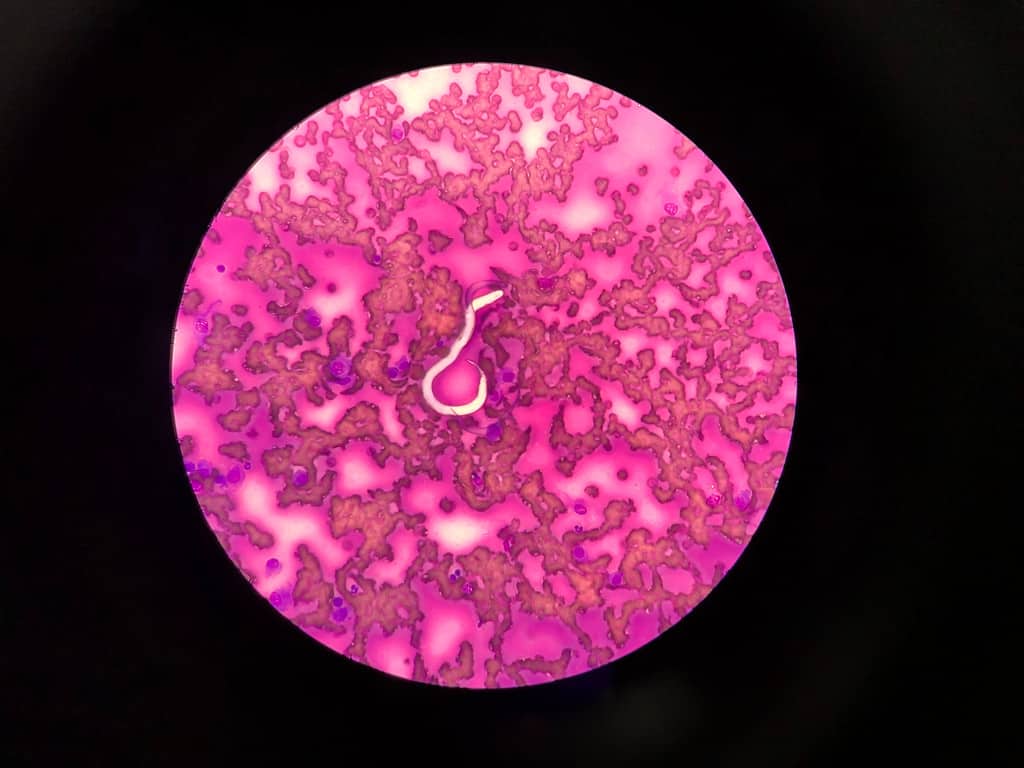Maltese dogs face multiple genetic health problems, many of which can be screened for by a reputable breeder. However, every Maltese will get sick at some point in their lifetime.
The most common Maltese health problems include dental disease, liver problems, heart conditions, eye conditions, and hypothyroidism. Most health problems develop later in a dog’s life, but some are present from birth or begin in young adulthood.
In this article, we’ll discuss 17 common Maltese health problems, their symptoms, and how they’re treated. We’ll also talk about how long the breed lives and how to keep your dog healthy.
1. Dental Disease

Brushing your Maltese’s teeth regularly can help to prevent dental disease.
©antoniodiaz/Shutterstock.com
Maltese are more prone to dental disease than larger dog breeds. The most common dental issue to watch for is periodontal disease, which is infection and inflammation around the base of a dog’s teeth. It can lead to deep-rooted infections and teeth falling out.
Like humans, dogs only have two sets of teeth–their puppy and adult teeth. Once an adult dog’s tooth falls out, it will not regrow.
Brush your Maltese’s teeth daily to fight plaque build-up and prevent dental disease. Examine their mouth as you brush, looking for redness and swelling in the gums, cracked or chipped teeth, and bad breath.
During your dog’s yearly check-up, your vet should look at their teeth and let you know whether they recommend a dental cleaning or any other dental work.
Dental disease is incredibly painful for dogs and can also lead to a plethora of other health problems, including heart, lung, and kidney disease. It’s also expensive to treat compared to the cost of a toothbrush and some dog toothpaste!
2. Eye Conditions

Several eye problems may occur for your Maltese, so look at them regularly for any change.
©Jolanta Beinarovica/Shutterstock.com
Eye conditions your Maltese are at heightened risk for include:
- Progressive Retinal Atrophy (PRA) – Dogs slowly lose their ability to see at night, and then at all. PRA is not painful for a dog but does lead to blindness and has no cure.
- Glaucoma – The eye cannot drain fluid properly, leading to increased pressure in the eye, optic nerve damage, and blindness. Immediate treatment is required and can prevent blindness from occurring.
- Ectopic cilia – A dog’s eyelashes grow inward, often requiring surgery to correct. The eyelashes that touch the eye cause discomfort, pain, ulcers, and infections.
If you notice problems with your Maltese’s eyes, even if they seem mild, please schedule a quick appointment with your veterinarian. Waiting for treatment can lead to worsened condition or blindness, and often leaves your dog in pain.
3. Heart Disease

Heart murmurs are common in Maltese.
©gorillaimages/Shutterstock.com
Reputable Maltese breeders will screen for heart disease in their dogs’ lineage and will never breed dogs with hereditary heart conditions.
Some heart problems you might notice in your Maltese include:
- Congestive heart failure – Congestive heart failure is most common in senior Maltese. The first symptom is increased respiratory rate, which can go unnoticed if you don’t monitor it at home. (A normal resting rate for dogs is 15-30 breaths per minute.) As the disease progresses your Maltese might have trouble breathing or exercising, cough, or faint. This is a deadly disease that typically kills dogs within two years.
- Patent Ductus Arteriosus (PDA) – This is a congenital heart murmur, which means that Maltese puppies are born with it. Your vet (or possibly yourself) will notice a noise alongside your dog’s heartbeat, which may be difficult to hear in a mild case or obvious in a severe case. Heart murmurs are rated on a scale of one to five with five being the most severe. Without treatment, many dogs will die before the age of two.
4. Hypothyroidism

If your Maltese has hypothyroidism, symptoms will be present when they are around age two or older.
©Tomsickova Tatyana/Shutterstock.com
With hypothyroidism, the thyroid fails to produce enough hormones, often due to the immune system attacking the organ. The body’s immune system slows, leading to weight gain despite a lack of changes to a Maltese’s diet or exercise routine.
Symptoms most commonly present when your Maltese is two years old or older. Your vet will run a simple blood test to diagnose thyroid disease and can treat it with medication.
5. Hydrocephalus

A particularly dangerous health condition for Maltese is hydrocephalus, or “water on the brain.”
©Arthur Lookyanov/Shutterstock.com
Hydrocephalus in Maltese typically develops soon after birth and is caused by congenital defects. Water accumulates around the brain, either because it cannot drain properly or is overproduced by the body.
This condition is also known as “water on the brain.” Your vet may prescribe medication to provide temporary relief until they can operate and place a shunt. Your primary veterinarian may refer you to a surgical or neurological specialist to complete the procedure if they’re unequipped to perform it themselves.
Not treating the condition can lead to permanent brain damage, disabilities, and death.
6. Luxating Patella

Some Maltese may have a kneecap that slides out of place and could require surgery.
©iStock.com/Mindaugas Dulinskas
The kneecap forms improperly and slides in and out of place as a dog moves. This condition ranges in severity.
Some Maltese can live with it their entire lives, while others need surgery to correct the issue. You may see your dog stop using one of their legs temporarily only to quickly return to walking on all fours. Half of dogs are affected in both knees.
7. Skin Infections

Routine grooming helps prevent mats, which can cause skin infections.
©Ana Vorkapic Marosevic/Shutterstock.com
Maltese coats are long and evergrowing, which means they can easily develop severe matting if not cared for. If mats aren’t dealt with, they can lead to a variety of skin issues including hot spots and skin infections.
A dog with matted fur is already in constant pain that worsens as they move. Skin infections only add to this pain, making the skin even more sensitive.
Short coats must be clipped every four to six weeks, and long coats must be brushed daily to prevent mats from forming in the coat.
8. Parasites

Heartworms and other parasites could pose a serious risk to your pet.
©wimala namket/Shutterstock.com
While they aren’t more prone to developing parasites than any other dog, it’s important your Maltese is on parasite prevention medication year-round. Pests are often hard to get rid of once they’ve infested your dog or your home.
Heartworm, which transfers from mosquitos, is one of the most painful pests your Maltese could acquire. Treatment for heartworm has improved in recent years but is still painful and requires restricted activity for months post-diagnosis.
9. Ear Infections

You should take your dog to the vet if you notice symptoms of ear infections, such as head shaking and redness.
©Lucky Business/Shutterstock.com
Maltese ears should be checked regularly for dirt, debris, and wax. The hair should also be clipped around the ears to keep them tidy.
Ear infections in Maltese are common and typically not severe. However, it’s important to get them to the vet as soon as you notice symptoms, which include head shaking, itching, redness, and swelling in the ear.
Waiting to treat an ear infection can lead to it spreading deeper into the ear, and even to other parts of the body such as the eyes or brain. When caught early, simple ear infections can be treated by cleaning the ear and applying medicated ointment prescribed by your vet.
Please do not attempt home remedies for ear infections, as they’re ineffective and often worsen the problem.
10. Asthma

Exercise intolerance, struggling to breathe, and wheezing are all signs of asthma in Maltese.
©fotovideoslk/Shutterstock.com
Asthma can impact a Maltese’s ability to breathe, leading to a dog struggling to breathe through the mouth, wheezing, or coughing. They’ll likely develop exercise intolerance as strenuous activities only further exert their lungs.
Most Maltese can live full lives with asthma so long as it’s treated using medication from the vet.
11. Deafness

Maltese can be born deaf or lose their hearing later in life.
©reery / flickr – License
Maltese are prone to congenital deafness, meaning they’re born without the ability to hear. This doesn’t tend to impact quality of life as the dogs don’t know the difference. With proper accommodations, deaf dogs can live just as richly as hearing dogs.
However, it’s important to only shop from reputable breeders who don’t breed deafness into their lines.
Your Maltese might also develop deafness throughout their life, which can be more difficult on the dog but typically doesn’t cause distress.
If your dog loses their hearing, please see a veterinarian to determine the underlying cause. Treatments such as clearing wax buildup might restore your dog’s hearing, or they may have a severe health problem that needs to be addressed.
Deaf dogs do require changes in routine, such as using hand motions rather than verbal cues and approaching your Maltese slowly to avoid startling them since they cannot hear you approach.
12. Colitis

Swollen colon, or colitis, often responds to medical interventions such as dietary change and medication.
©Jeffry S/Shutterstock.com
A swollen colon causes diarrhea, pain, spasms, blood or mucus in the stool, and vomiting. Most dogs with colitis recover quickly with veterinary treatment.
Your vet may recommend fasting your dog for a short period, making dietary changes, or giving them medications. Extensive testing may be required to diagnose colitis or to find an underlying cause, especially in cases where it’s severe and recurring.
13. Collapsed Trachea

Middle age is when you commonly see signs of collapsed trachea in a Maltese, though not always.
©Carnivorka/Shutterstock.com
A dog’s trachea, or windpipe, collapses, obstructing their ability to breathe. They may cough and struggle to exercise.
Collapsed trachea can happen at any age but most commonly begins in middle age. Some Maltese can be successfully treated with medications, while others will need surgery to correct the issue.
14. Portosystemic Shunts (PSS)

Liver problems can occur in Maltese puppies.
©iStock.com/Pratchaya
Liver shunt blocks blood flow to the liver, which has the job of filtering toxins, proteins, and nutrients from the blood. In most cases, puppies are born with these shunts.
Shunts can lead to decreased liver size, impaired central nervous system functioning, and impaired liver function.
You might notice a lack of normal growth, muscle development, and neurological symptoms.
Prognosis varies based on severity but this condition is often life-limiting. Surgery can be curative in mild cases, and many dogs can get relief through medications and dietary changes which allow them to live longer lives than they could without treatment.
15. Hepatic Microvascular Dysplasia (MVD)

Hepatic microvascular dysplasia causes atrophy in the liver.
©iStock.com/Laures
Another liver problem you might see in your Maltese is Hepatic microvascular dysplasia, also known as portal vein hypoplasia.
This causes a lack of blood vessels or underdeveloped blood muscles inside the liver, causing similar symptoms to portosystemic shunts. The two are often connected but MVD can develop on its own as well.
16. Cancer

Any dog breed can get cancer, and it may strike senior Maltese.
©CI Photos/Shutterstock.com
Cancer is a leading cause of death in adult dogs of any breed and will be seen most commonly in senior Maltese.
Cancers range in severity and prognosis. Some dogs will go into remission with treatments such as surgery, and go on to live long lives. Others with aggressive cancers may only have weeks or months to live post-diagnosis.
Early treatment can make a huge difference, so please make an appointment with your veterinarian if you notice abnormalities in your dog’s behavior, if they seem to be in pain, or if you notice any lumps on their skin.
17. White Dog Shaker Syndrome

Small dogs with white coats are most prone to shaker syndrome.
©Tomsickova Tatyana/Shutterstock.com
Often known simply as shaker syndrome, this condition primarily affects small white dogs like Maltese. Dogs will typically develop tremors at one to two years old. These tremors vary in severity and may worsen when your dog is excited or during exercise.
Though it can seem scary, most dogs do well once prescribed steroids as treatment and can go on to live full, happy, and tremor-free lives.
How to Keep Your Maltese Healthy

Diet, exercise, and veterinary care can extend your Maltese’s lifespan.
©Mihalovna/Shutterstock.com
A Good Diet
One of the most important ways to keep your Maltese healthy is to feed a high-quality, veterinarian-recommended kibble in the right amounts.
Most vets recommend foods that meet WSAVA guidelines, meaning they’re scientifically proven to be healthy for our dogs. This is especially important since we don’t yet know for sure what’s caused the influx of heart disease in dogs, which may be linked to certain ingredients used in grain-free foods and boutique dog food brands.
Feeding the right amount of food keeps your Maltese at a healthy weight, which can give them several more years of life than overweight dogs.
Daily Exercise
Small breeds still need daily exercise to maintain good health. Most Maltese require a half hour or more of exercise each day.
This can include daily walks, playtime inside, or running around the backyard. Just like people, Maltese who are physically fit tend to stay healthier for longer.
Routine Check-Ups
A good vet can make a world of difference in your dog’s health. Your Maltese should see the vet for a check-up once yearly throughout young adulthood and every six months once they enter their senior years.
Monitoring Health at Home
Monitoring your Maltese’s health at home means you’ll pick up on health problems earlier than you would if waiting for your yearly appointment.
Check over your dog’s body while grooming, including their eyes, ears, and mouth. Watch them for changes in behavior, which are often the first symptoms of illness or pain.
If you notice anything amiss, schedule an appointment with your veterinarian to have your dog seen as soon as possible.
Reputable Breeders
Reputable breeders run extensive health testing on their dogs to ensure they aren’t breeding genetic conditions into their puppies. Never adopt from a breeder without up-to-date OFA health testing on both parents and a reference number for their veterinarian.
How Long do Maltese Live?

Some Maltese live to be over 15 years old!
©Dora Zett/Shutterstock.com
Maltese live an average of 12-15 years, with some living well beyond these numbers. Sadly, there are also poorly bred Maltese puppies who live much shorter lives as well.
While you can never fully control how long your Maltese lives, following the advice above and staying informed when it comes to their health is your best chance of providing them with both quality and quantity of life.
Thank you for reading! If you have feedback on this post, please contact the AZ Animals editorial team.
The photo featured at the top of this post is © reery / flickr – License / Original
Ready to discover the top 10 cutest dog breeds in the entire world?
How about the fastest dogs, the largest dogs and those that are -- quite frankly -- just the kindest dogs on the planet? Each day, AZ Animals sends out lists just like this to our thousands of email subscribers. And the best part? It's FREE. Join today by entering your email below.
Thank you for reading! Have some feedback for us? Contact the AZ Animals editorial team.






